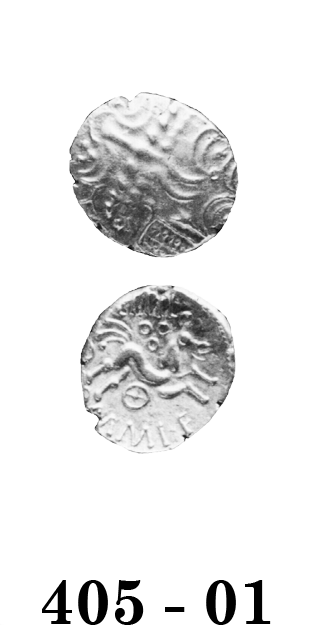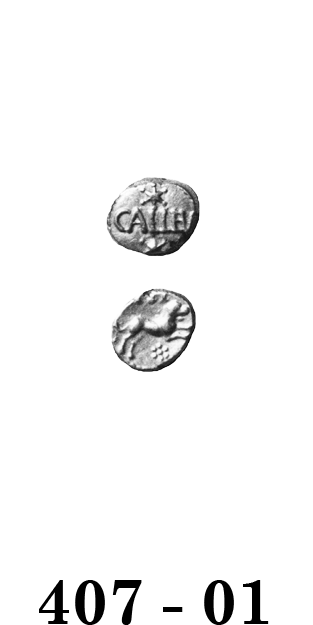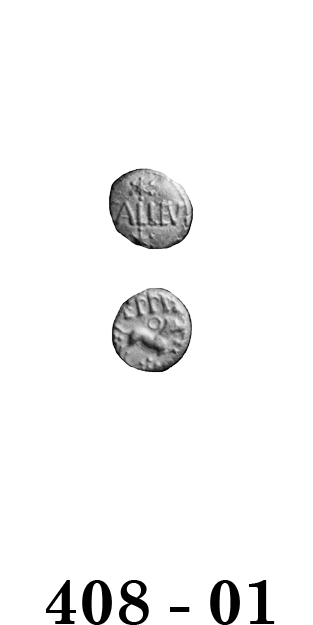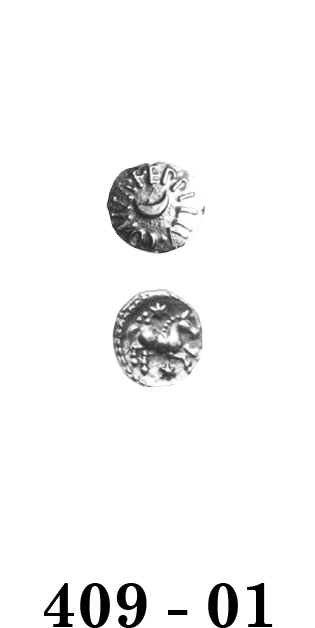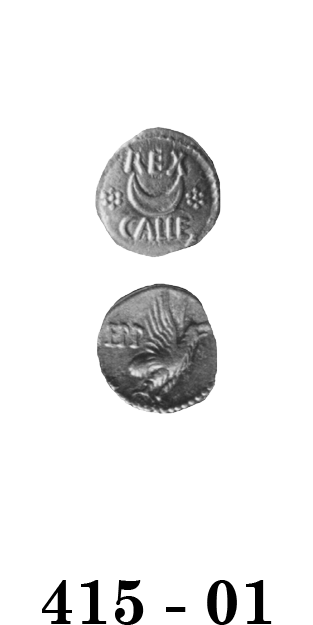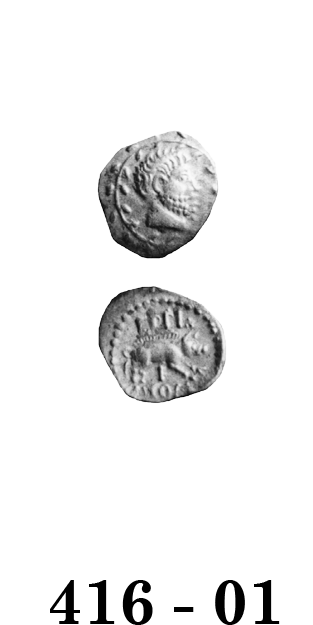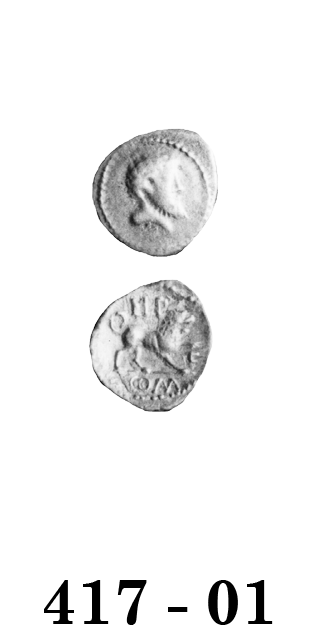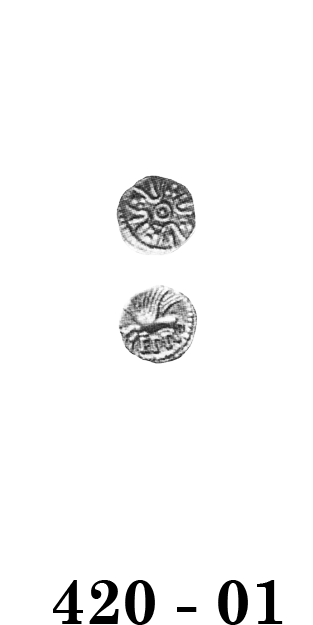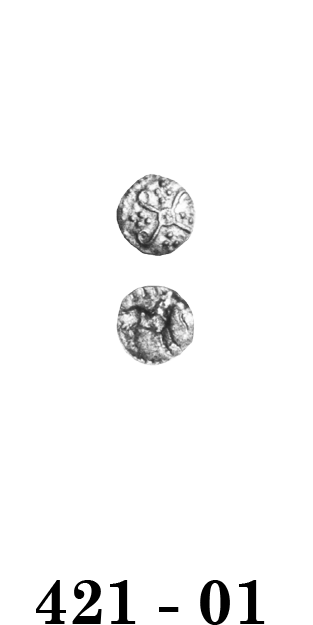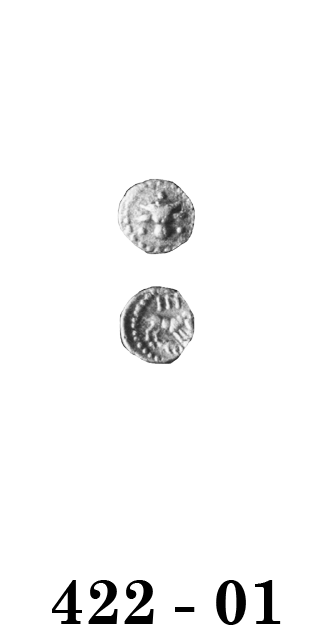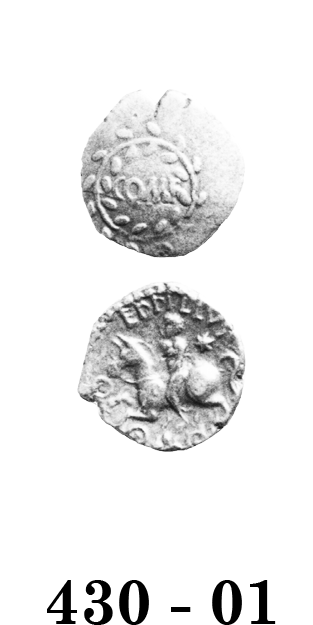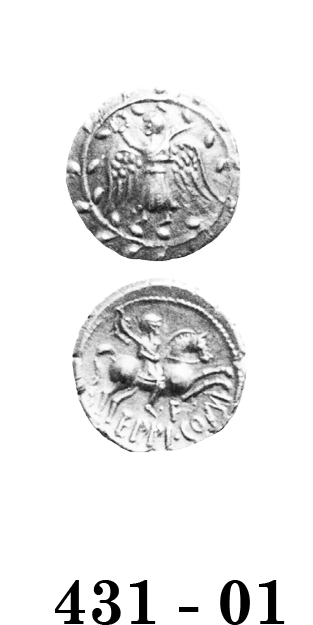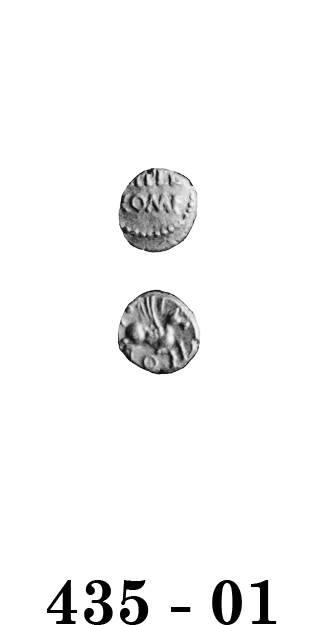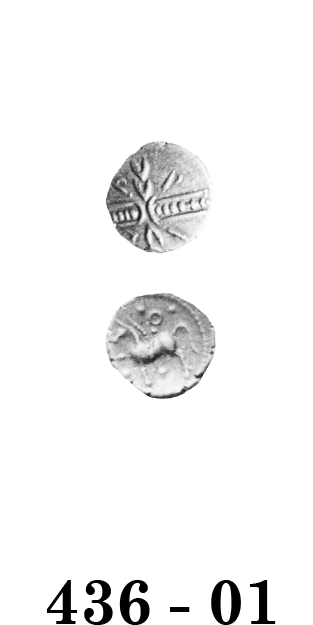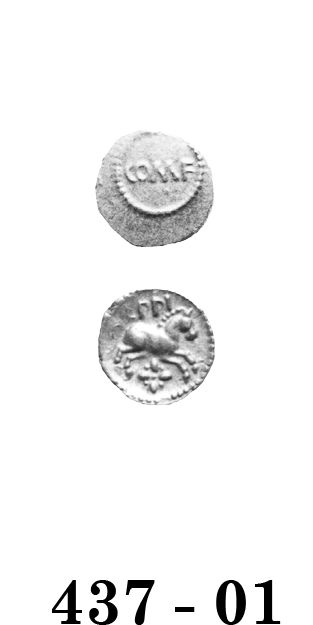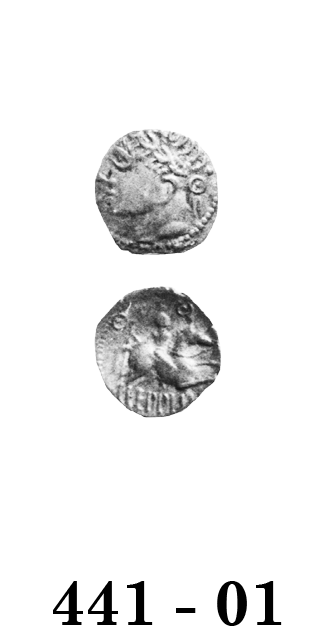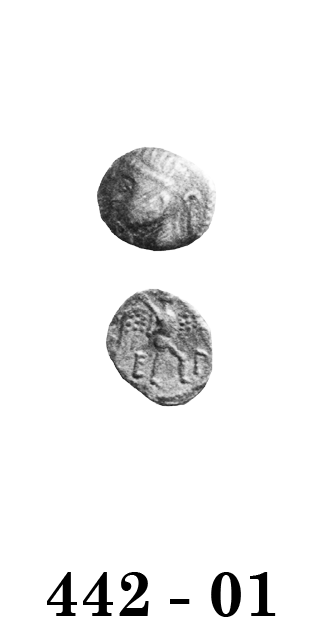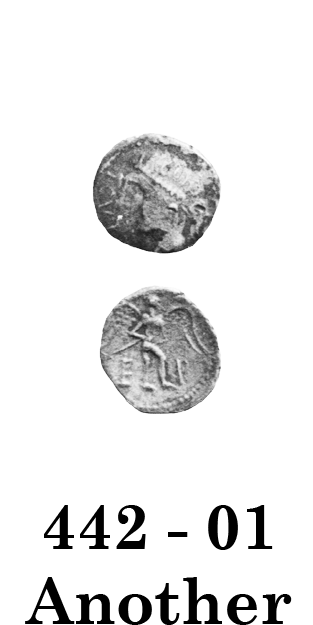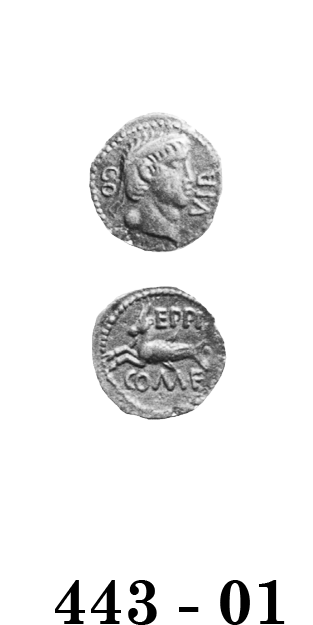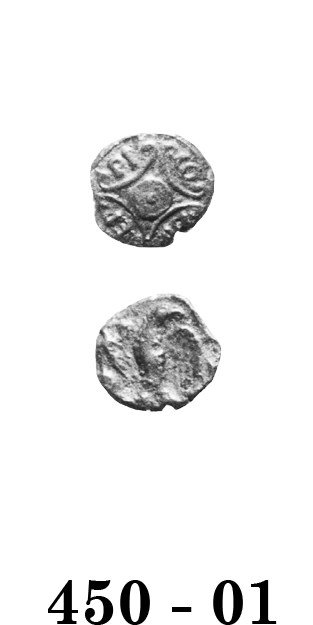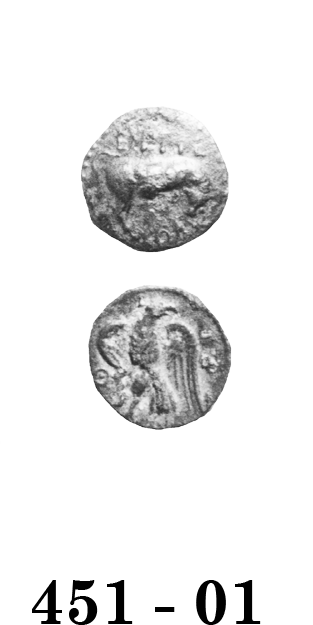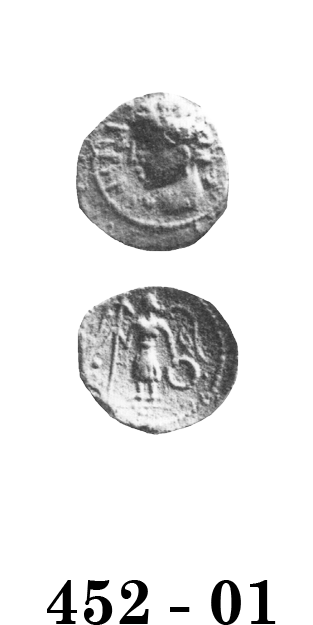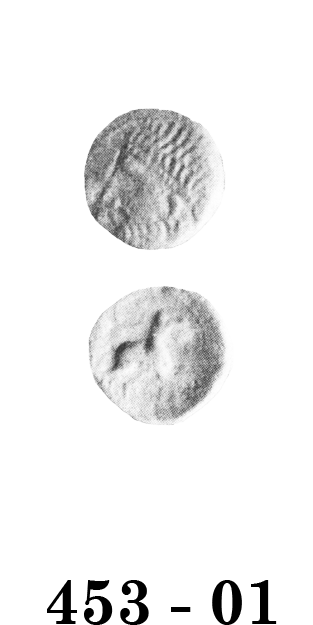
Celtic Coinage of Britain
third edition
Click on coin to see hidden information
The Coinage of Eppillus
Eppillus' coins are divided into two distinct issues, the Calleva types and the Kentish types. Eppillus assumed the Atrebatic/Regnan leadership after Tmcommius had been deposed and exiled about the time of the Trinovantian/ Catuvellaunian Interregnum. Sometime after 10 B.C., Trinovantian/Catuvelluanian power was rendered ineffective by the tribe's internal problems and Eppillus decided to test its strength by invading Kent.
The Cantii had used Trinovantian/Catuvellaunian coins for some time issuing few of their own. Now, a new series appeared carrying the name Eppillus. Eppillus also issued a victory stater in Kent, supporting the idea of a military incursion. By 10 A.D., Cunobeline assumed leadership of the Trinovantes/Catuvellauni and proceeded to drive Eppillus from Kent. Eppillus disappeared about this time, he was probably killed during the incursion in Cantian territory.
The Calleva types, all struck at Silchester, are the normal Atrebatic/Regnan coins of Eppillus. The Kentish types constitute an emergency coinage struck to finance military operations.
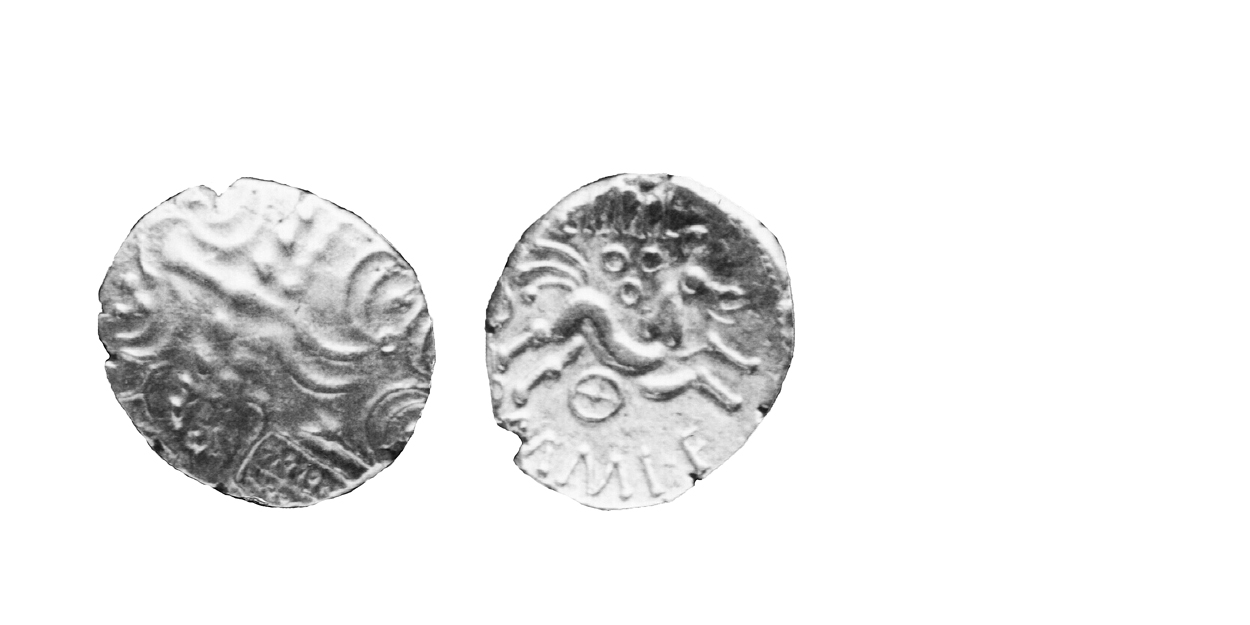
405 - 01 Eppillus Early Type
10 B.C.-10 A.D. Very Rare
Gold Stater 5.2 gms. 17 mm
Earliest Record: Van Arsdell, 1989
OBV: Celticized head of Apollo right
Identifying points:
1) spike made up of lines and pellets
2) wreath: leaves downwards
REV: Celticized horse right
Identifying points:
1) EPPI above horse
2) COMMI F below horse
3) three ringed object above horse reminiscent of the Llyn Cerrig Bach gang-chain
4) four-spoked wheel below horse
5) triple tail on horse
CLASSIFICATION: Atrebatic G
NOTES:
- Weight of one recorded example given
- A most exceptional coin
- The die-cutting and striking appear to be correct for Atrebatic/Regnan work of the time, and the colour appears correct
- Metallurgical data recently confirms authenticity of this coin
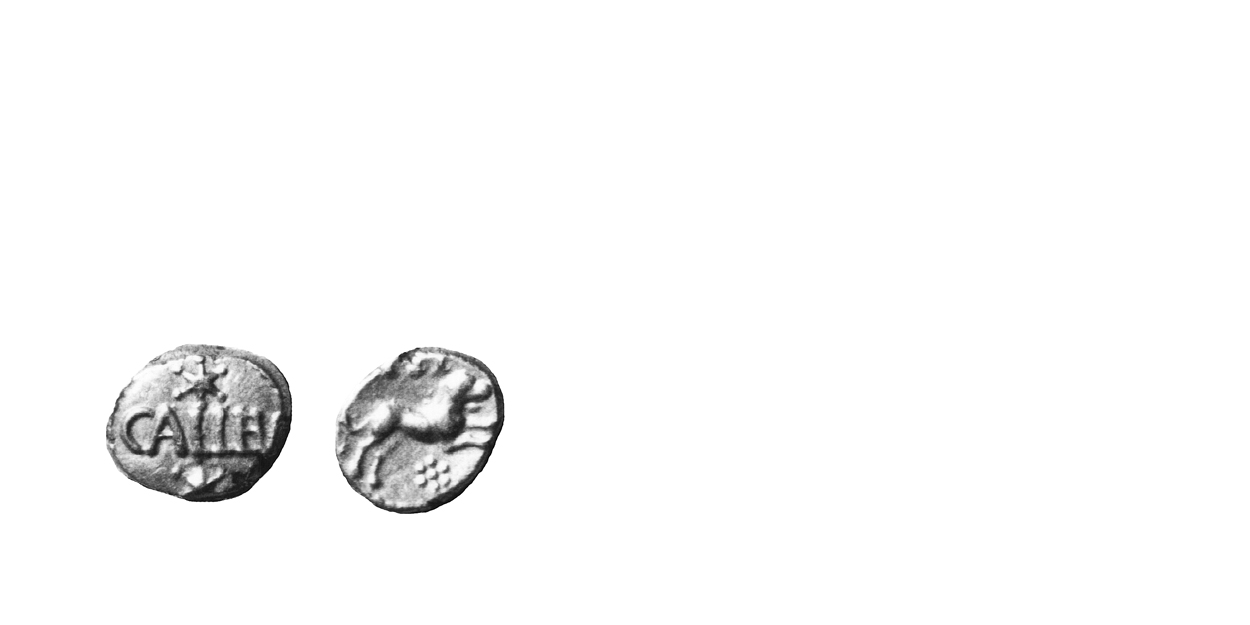
407 - 01 Eppillus
10 B.C.-10 A.D. Rare
Gold Quarter stater 1.0-1.2 gms. 9 mm
Earliest Record: Evans, 1890
OBV: Inscription in pellet border
Identifying points:
1) CALLE
2) six pointed star above and below inscription
REV: Celticized horse right
Identifying points:
1) EPPI above horse
2) daisy below horse
CLASSIFICATION: Atrebatic G
NOTES:
- Many found at Wanborough
- Typical weight given
- Modern forgery exists – see 407 -01F
- Celtic Coin Index records indicate rarer than originally thought
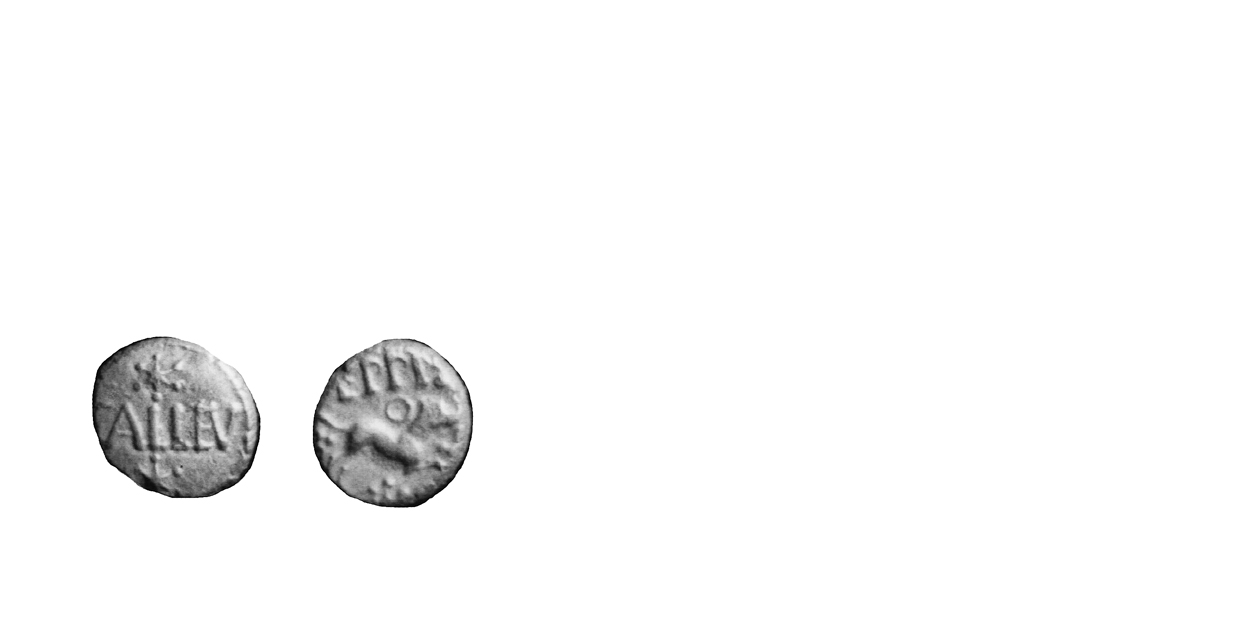
408 - 01 Eppillus
10 B.C.-10 A.D. Extremely Rare
Gold Quarter stater 1.2 gms. 10 mm
Earliest Record: Van Arsdell, 1989
OBV: Inscription in pellet border
Identifying points:
1) as 407 - 01
REV: Celticized horse right
Identifying points:
1) as 407 - 01
2) ring above horse
CLASSIFICATION: Atrebatic G
NOTES:
- Some found at Wanborough
- Typical weight given
- Celtic Coin Index records indicate rarer than originally thought
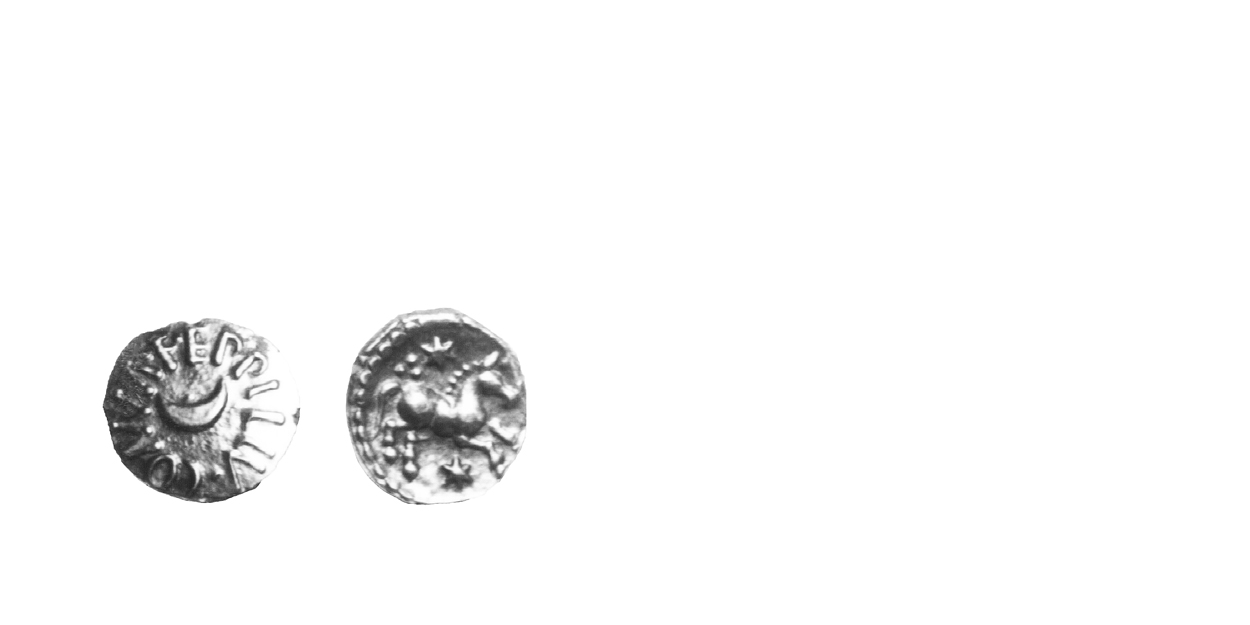
409 - 01 Eppillus
10 B.C.-10 A.D. Extremely Rare
Gold Quarter Stater 1.2 gms. 9 mm
Earliest Record: Van Arsdell, 1989
OBV: Crescent with inscription
Identifying points:
1) crescent in centre
2) COMM.F.EPPILLV. around crescent
REV: Celticized horse right
Identifying points:
1) six pointed star above and below horse
CLASSIFICATION: Atrebatic G
NOTES:
- Typical weight given
- Some found at Wanborough
- Celtic Coin Index records indicate rarer than originally thought
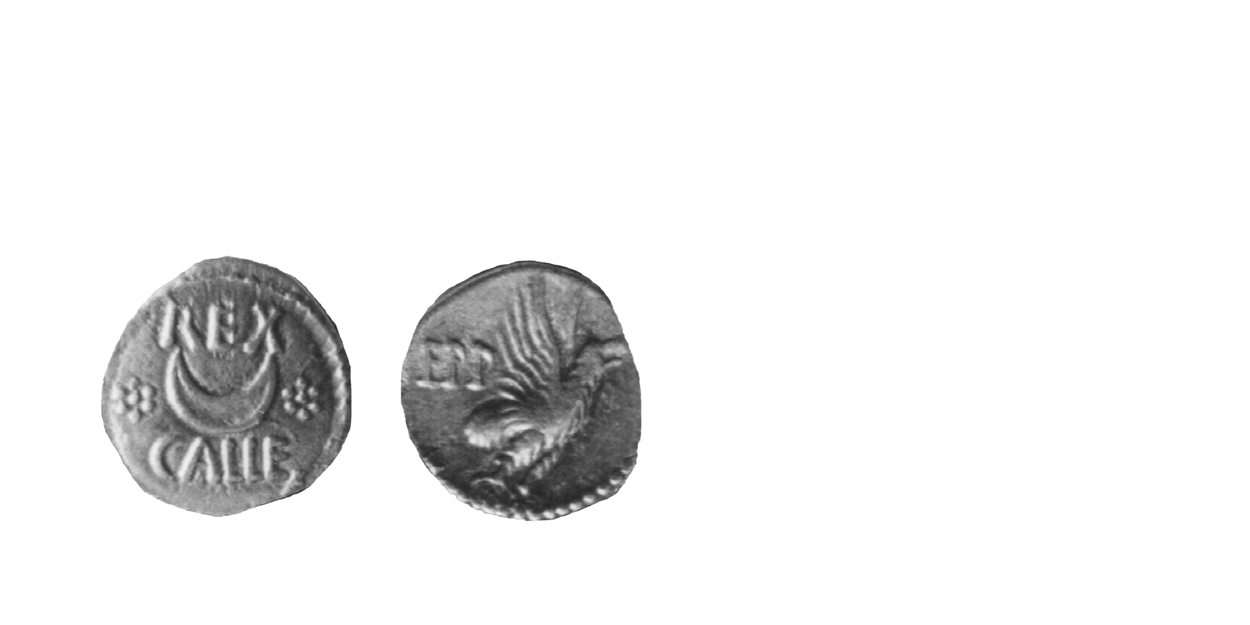
415 - 01 Eppillus
10 B.C.-10 A.D. Scarce
Silver Unit 1.2 gms. 13 mm
Earliest Record: Camden, 1610 (Philemon Holland edition)
OBV: Crescent with inscription
Identifying points:
1) outline crescent, points upwards, in centre
2) REX above crescent
3) CALLE below crescent
4) daisy on either side of crescent
5) pellet border
REV: Eagle right
Identifying points:
1) eagle's wing spread
2) EPP above eagle's tail
3) pellet border
CLASSIFICATION: Atrebatic G
NOTES:
- Many found at Wanborough
- Mack transposed the obverse and reverse designations
- The crescent is on the convex side and the eagle on the concave
- Variety with obverse legend REX CALL awaits metallurgical analysis to verify authenticity
- Catalogue number 415 - 03 reserved for the REX CALL type
- Obverse adapted from a denarius of L. Lucretius Trio
- Reverse adapted from a denarius of Cn. Nerius or Augustus Turpilianus
- Celtic Coin index records indicate rarer that originally thought
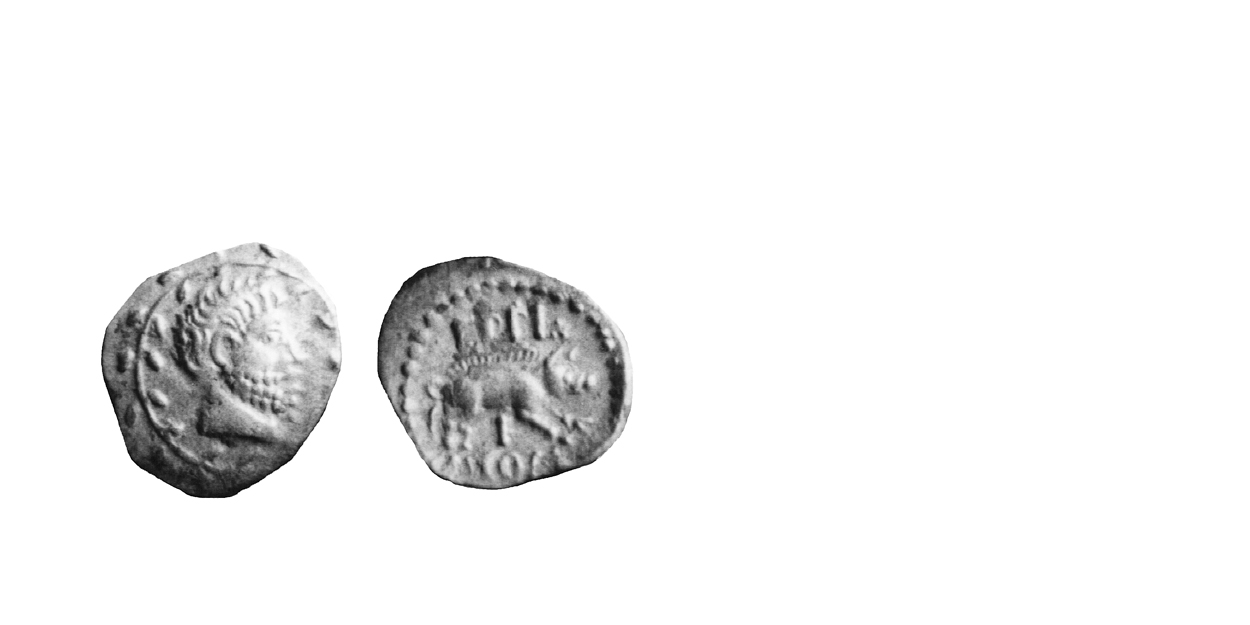
416 - 01 Eppillus
10 B.C.-10 A.D. Scarce
Silver Unit 12 mm
Earliest Record: Van Arsdell, 1989
OBV: Celticized head right
Identifying points:
1) beard made up of pellets
2) vine border
REV: Boar right
Identifying points:
1) EPPI above boar
2) three pellets after EPPI
3) COM below boar
4) F above COM
5) pellet border
CLASSIFICATION: Atrebatic G
NOTES:
- Many found at Wanborough
- Celtic coin Index records indicate rarer that originally thought
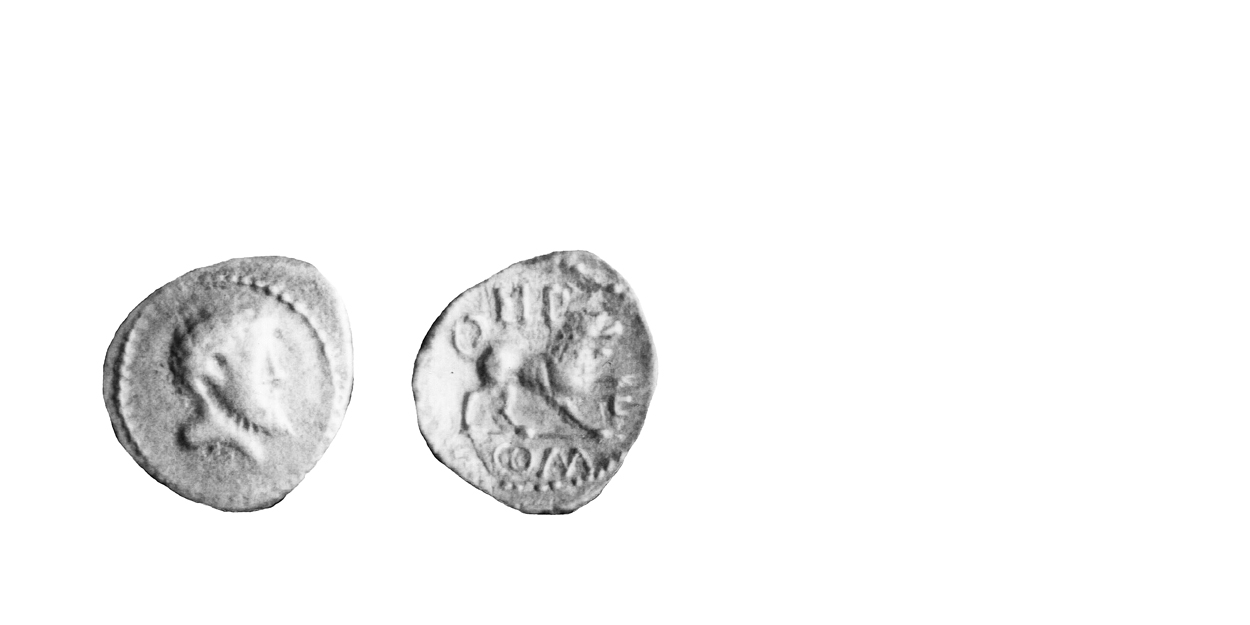
417 - 01 Eppillus
10 B.C.- 10 A.D. Scarce
Silver Unit 1.2 gms. 13 mm
Earliest Record: Evans, 1890
OBV: Celticized head right
Identifying points:
1) similar head to that on 416 - 01
2) beard made up of strokes
3) pellet border
REV: Lion right
Identifying points:
1) lion stands on exergual line
2) EPP above lion
3) COM below exergual line
4) F in front of lion
CLASSIFICATION: Atrebatic G
NOTES:
- Many found at Wanborough
- Previously, this type was listed by Mack as a Kentish type, but many of these and similar types have recently been found in the normal tribal area
- Reverse adapted from a denarius of Mark Anthony
- Celtic Coin Index records indicate rarer that originally thought
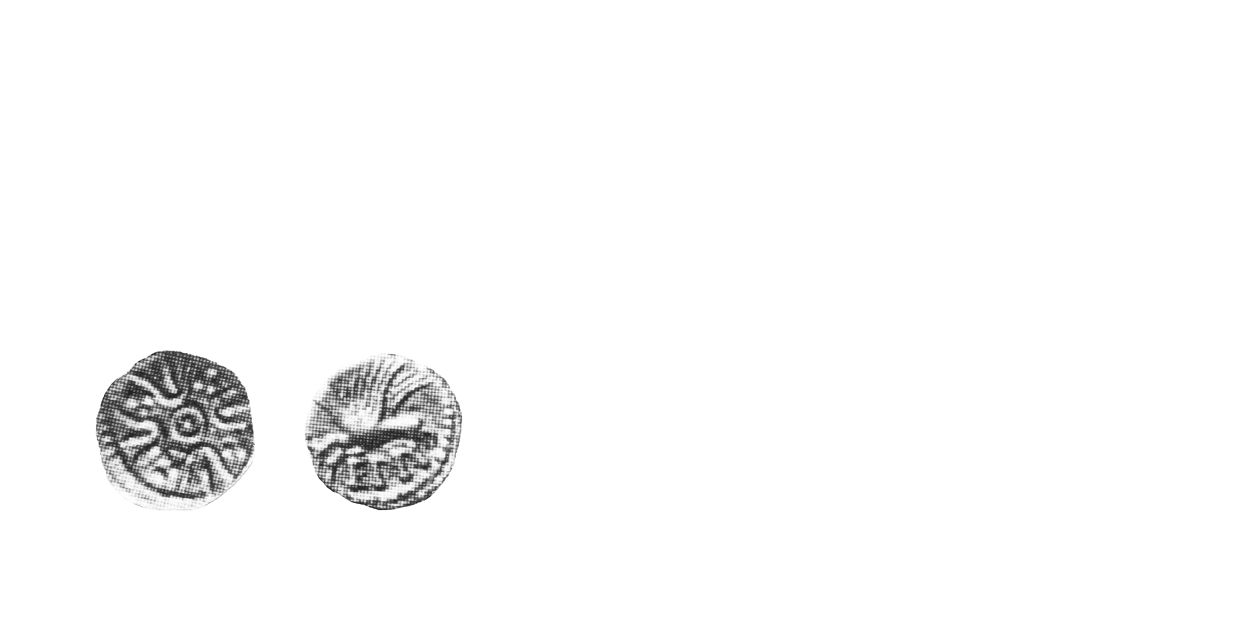
420 - 01 Eppillus
10 B.C.-10 A.D. Extremely Rare
Silver Minim 0.3 gms. 8 mm
Earliest Record: Van Arsdell, 1989
OBV: Floral pattern
Identifying points:
1) pellet-in-ring motif in centre
2) Two Us with line in centre, pointing outwards around edge
3) pellet between the two Us
4) pellet border
REV: Eagle right
Identifying points:
1) eagle as on 415 - 01
2) EPPI in front of eagle
3) pellet border
CLASSIFICATION: Atrebatic G
NOTES:
- Some found at Wanborough
- Type appears genuine, awaits metallurgical analysis to establish authenticity
- Rarity provided via trade survey
- Celtic Coin Index records indicate rarer that originally thought
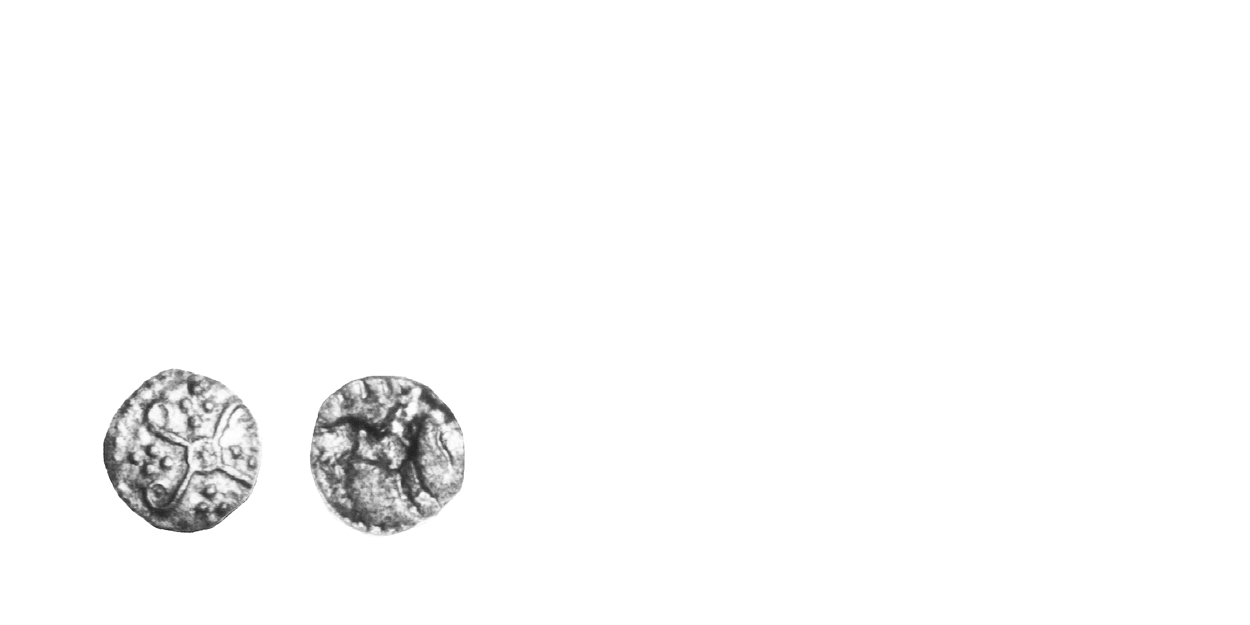
421 - 01 Eppillus
10 B.C.-10 A.D. Extremely Rare
Silver Minim 0.3 gms. 9 mm
Earliest Record: Van Arsdell, 1989
OBV: Spiral pattern
Identifying points:
1) four armed spiral
2) four pellets in each angle
3) pellet-in-ring motif in centre
4) pellet border
REV: Celticized horse right
Identifying points:
1) EPP above horse
CLASSIFICATION: Atrebatic G
NOTES:
- Some found at Wanborough
- Type appears genuine, awaits metallurgical analysis to establish authenticity
- Celtic Coin Index indicates rarer than originally thought
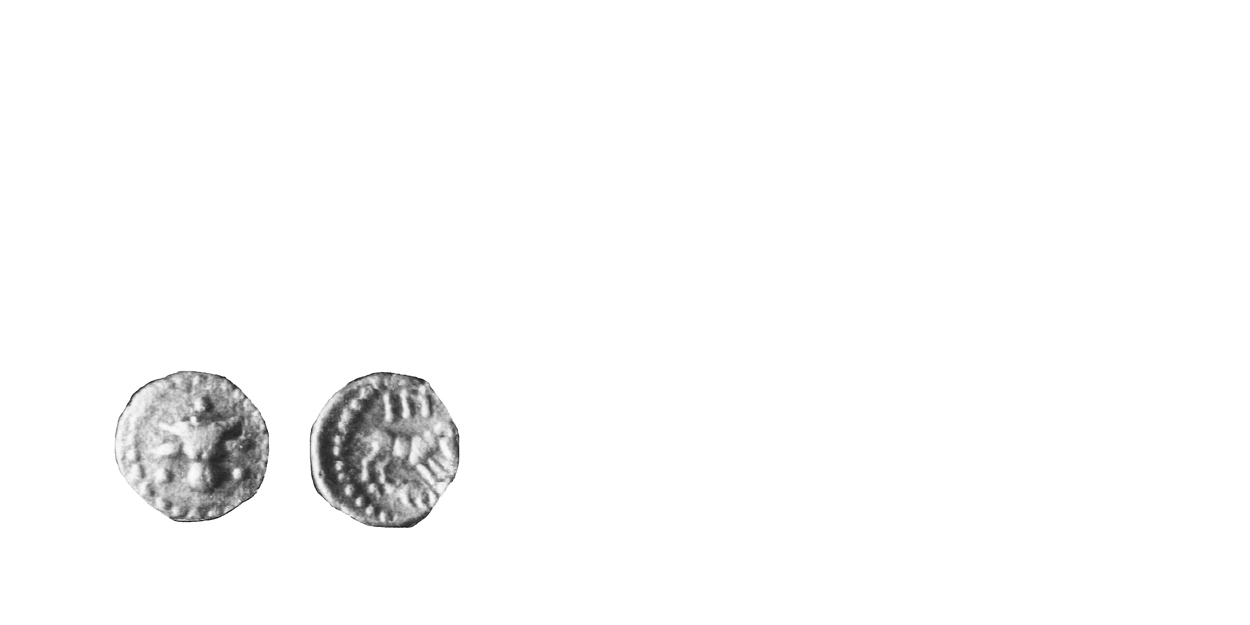
422 - 01 Eppillus
10 B.C.-10 A.D. Extremely Rare
Silver Minim 8 mm
Earliest Record: Van Arsdell, 1989
OBV: Bull's head facing
Identifying points:
1) pellet above and on each side of bull's head
2) pellet border
Identifying points:
1) EPP above ram
CLASSIFICATION: Atrebatic G
NOTES:
- Some found at Wanborough
- Type appears genuine, awaits metallurgical analysis to establish authenticity
423 – 01 now reattributed as 475 - 01
A better-preserved example now shows the legend "VERICA" on the obverse.
Go to 475-01
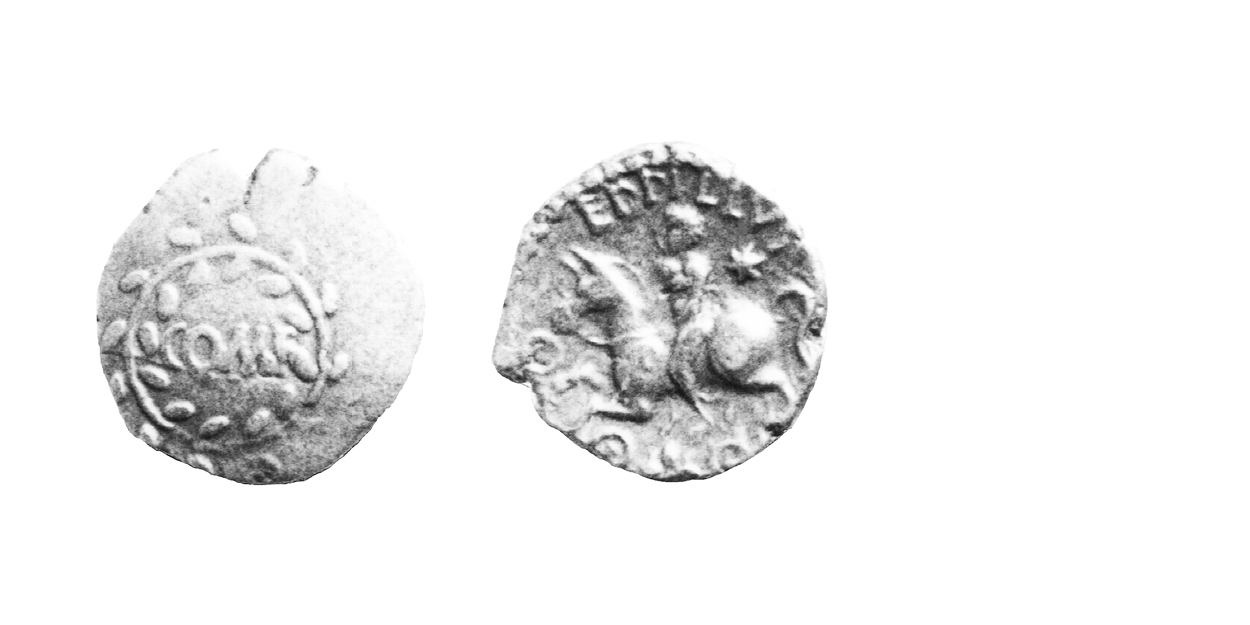
430 - 01 Eppillus Kentish Type
10 B.C.-10 A.D. Extremely Rare
Silver Stater 5.40 gms. 17 mm
Earliest Record: Evans, 1864
OBV: Inscription in wreath
Identifying points:
1) COMF in wreath
2) wreath has leaves pointing in the clockwise direction
REV: Celtic warrior on horse left
Identifying points:
1) flower below horse
2) pellet-in-ring motifs in field
3) six pointed star above horse
4) EPPILLVS above rider
CLASSIFICATION: Atrebatic H
NOTES:
- Standard weight given
- Most in museums
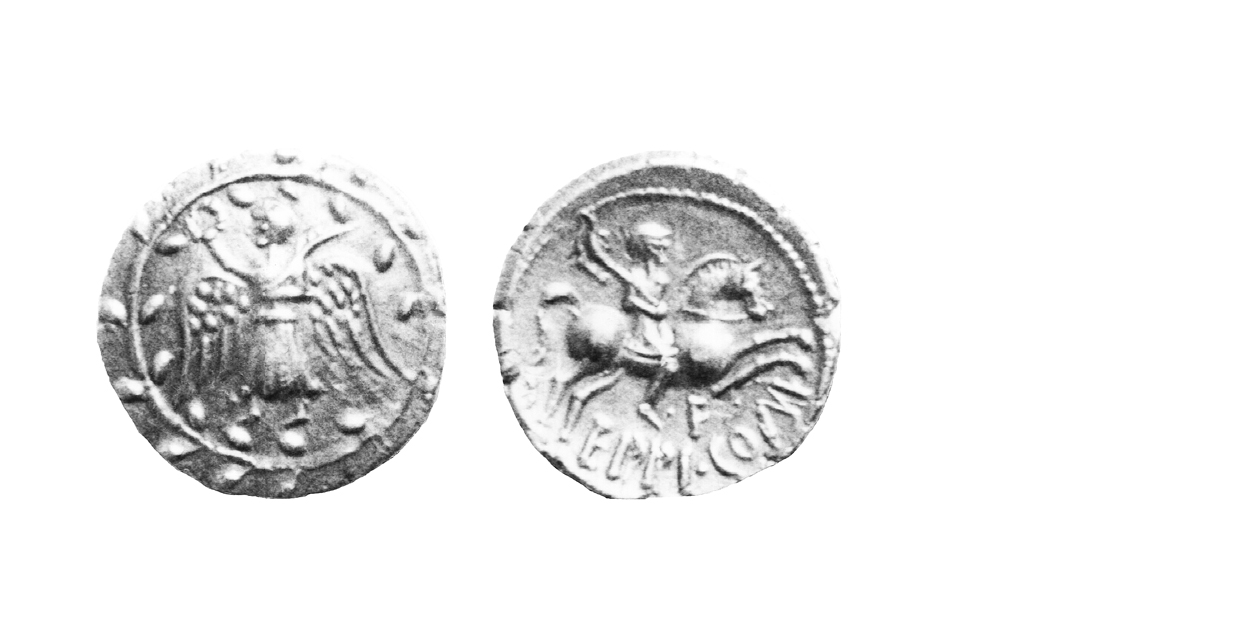
431 - 01 Eppillus Victory Type
10 B.C.-10 A.D. Extremely Rare
Gold Stater 5.40 gms. 18 mm
Earliest Record: Poste, 1846
OBV: Victory left
Identifying points:
1) victory hold wreath in left hand
2) wreath border has leaves pointing in counter-clockwise direction
REV: Celtic warrior on horse right
Identifying points:
1) rider holds carnyx over his shoulder
2) EPPI.COM below horse
3) F above EPPI.COM
CLASSIFICATION: Atrebatic H
NOTES:
- Standard weight given
- Most in museums
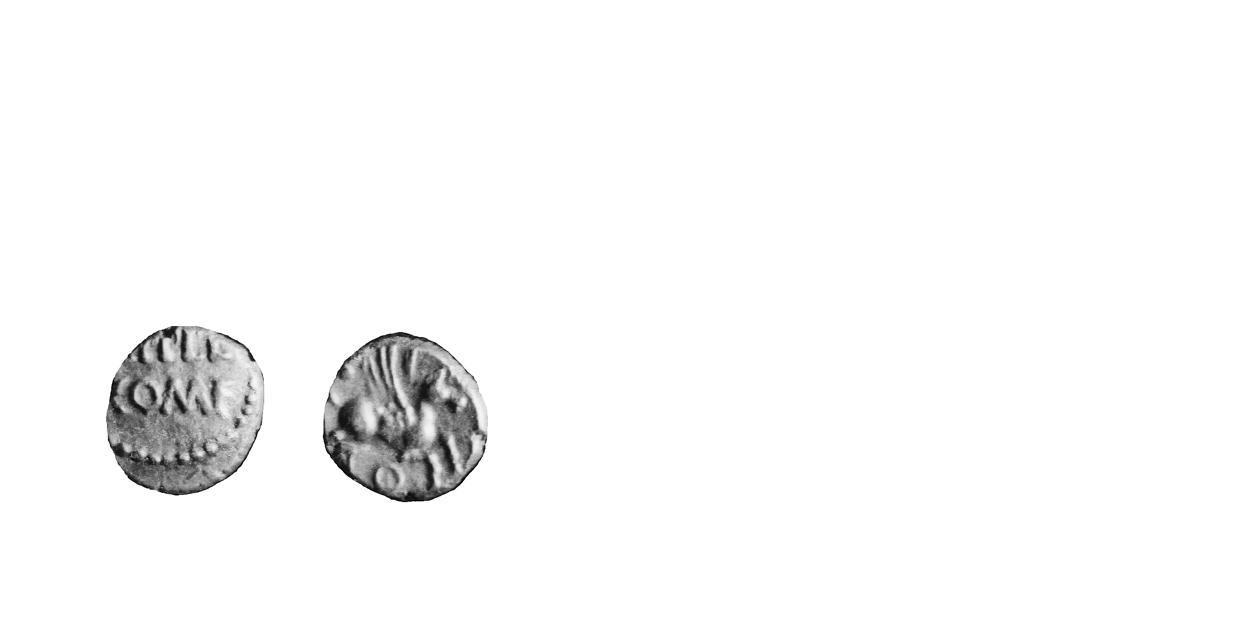
435 - 01 Eppilus Kentish Type
10 B.C.-10 A.D. Rare
Gold Quarter Stater 1.2 gms. 9 mm
Earliest Record: Evans, 1864
OBV: Inscription
Identifying points:
1 EPPIL COMF in two lines
REV: Pegasus right
Identifying points:
1) ring below Pegasus may be a pellet-in-ring motif
CLASSIFICATI()N: Atrebatic H
NOTES:
- Typical weight given
- Many found at Wanborough
- Recent finds indicate this type also circulated in the normal Atrebatic/Regnan territory
- Celtic Coin Index indicates rarer than thought
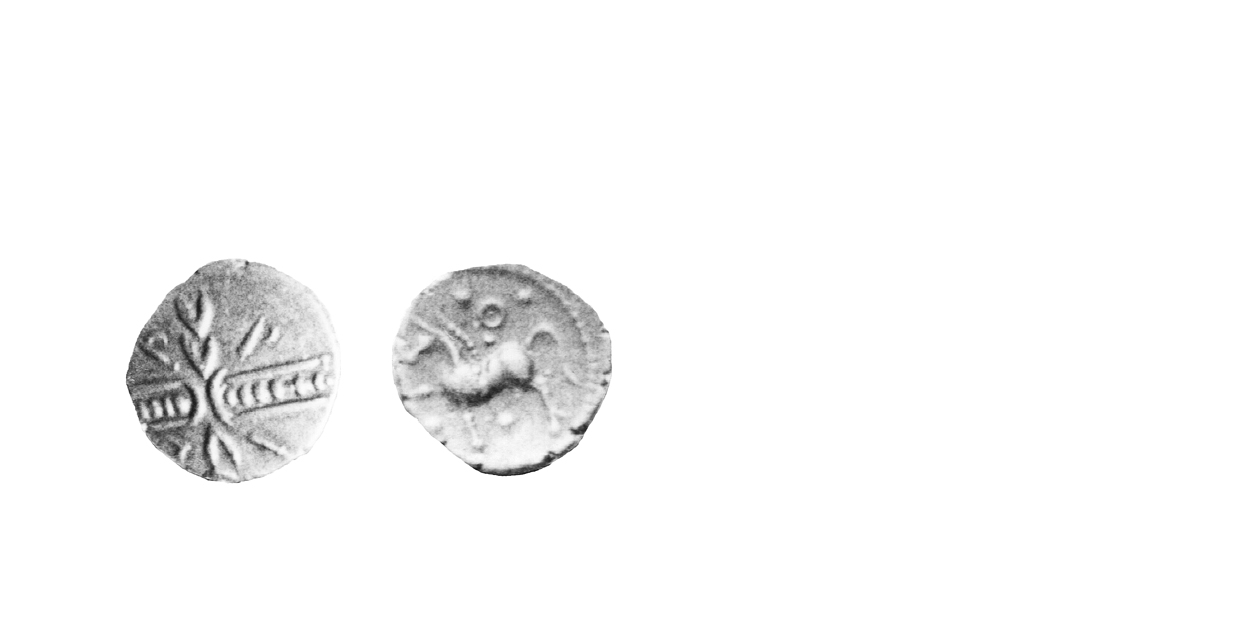
436 - 01 Eppillus Kentish Type
10 B.C.-10 A.D. Extremely Rare
Gold Quarter Stater 1.5 gms. 10 mm
Earliest Record: Poste, 1846
OBV: Crossed wreaths
Identifying points:
1) one of the crossed wreaths has leaves inwards
2) EPPI in angles of wreaths
REV: Celticized horse left
Identifying points:
1) ring and three pellets above horse
2) pellet below horse
3) pellet border
CLASSIFICATION: Atrebatic H
NOTES:
- Weight of existing example given
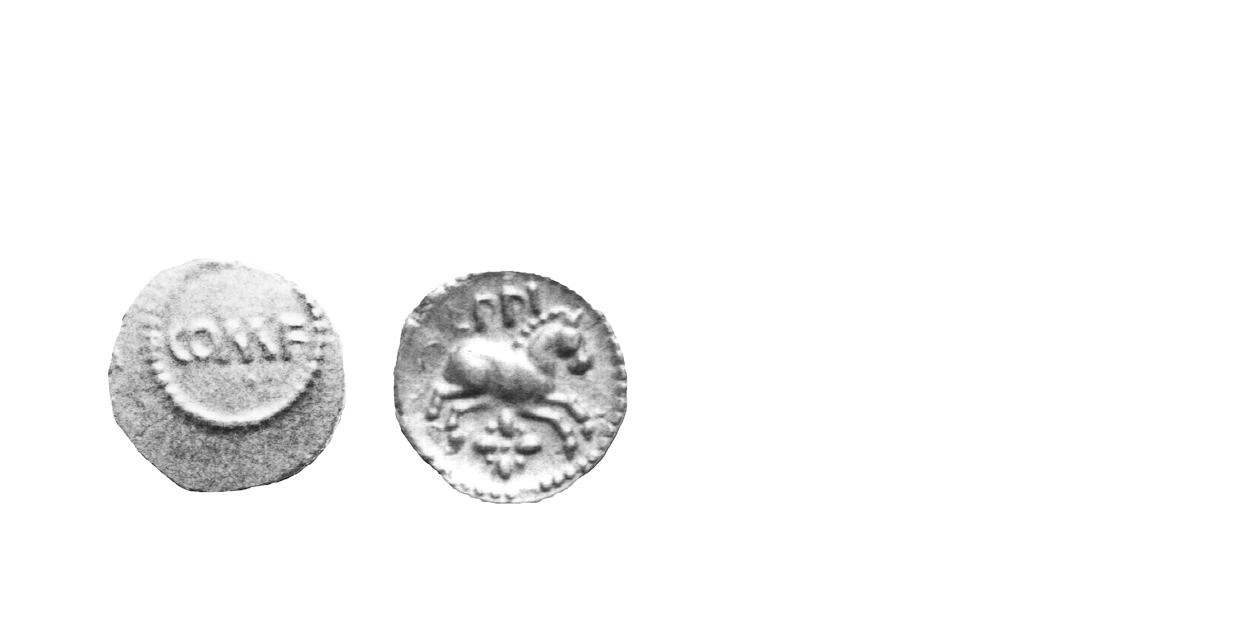
437 - 01 Eppillus Kentish Type
10 B.C-10 A.D. Extremely Rare
Gold Quarter Stater 1.3 gms. 12 mm
Earliest Record: Evans, 1864
OBV: Inscription in ring
Identifying points:
1) COMF in ring
2) ring made up of large pellets
REV: Celticized horse right
Identifying points:
1) EPPI above horse
2) flower below horse
3) pellet border
CLASSIFICATION: Atrebatic H
NOTES:
- Typical weight given
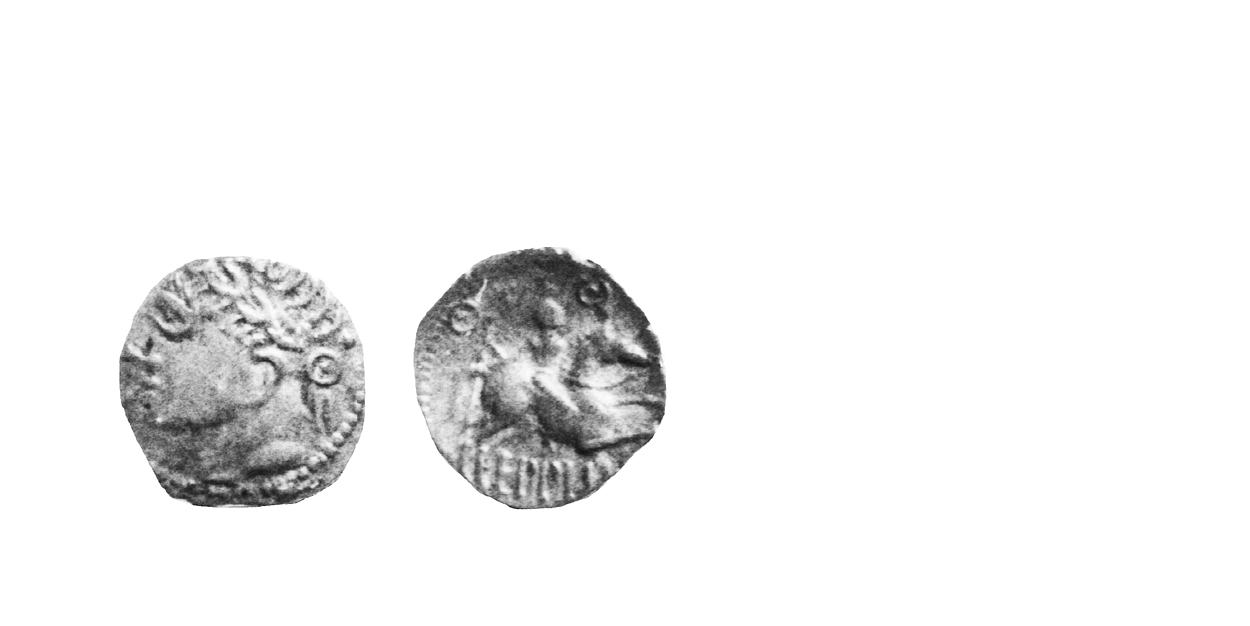
441 - 01 Eppillus
10 B.C.-10 A.D. Extremely Rare
Silver Unit 13 mm
Earliest Record: Poste, 1846
OBV: Romanized head left
Identifying points:
1) head laureate
2) EPPIL. in field
3) pellet border
REV: Celtic warrior riding horse right
Identifying points:
1) rider carries carnyx
2) EPPILL below horse
3) pellet-in-ring motif behind carnyx
4) pellet border
CLASSIFICATI()N: Atrebatic H
NOTES:
- Type probably adapted from a denarius of Augustus
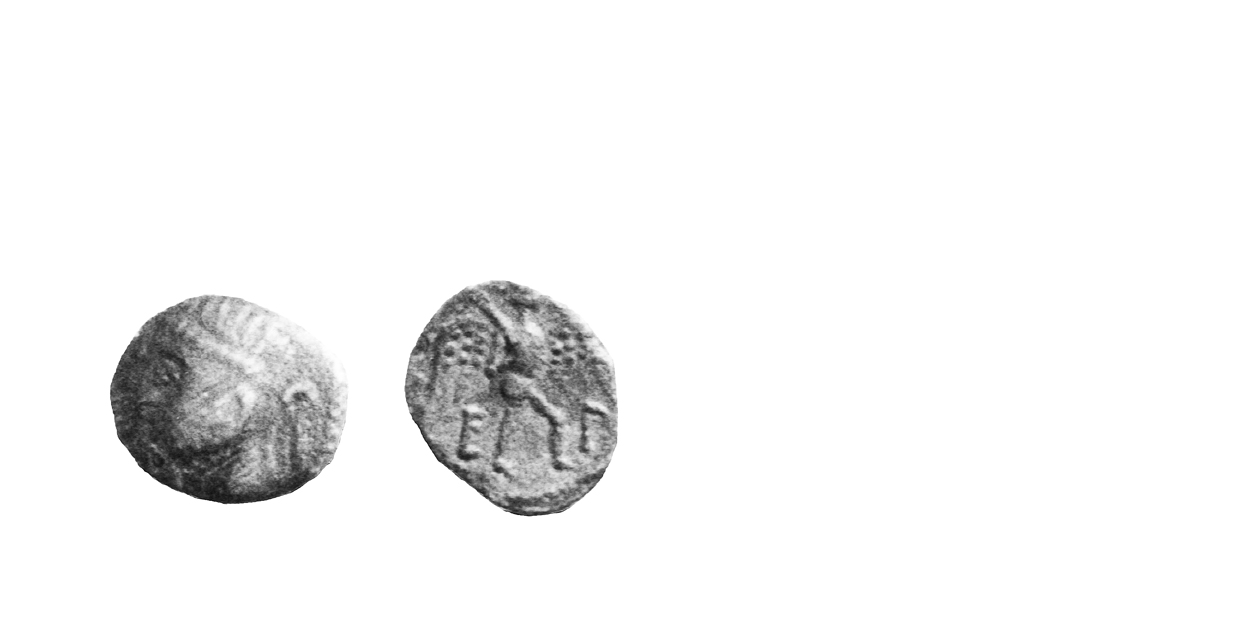
442 - 01 Eppillus Victory Type
10 B.C.-10 A.D. Extremely Rare
Silver Unit 1.3 gms. 12 mm
Earliest Record: Evans, 1864
OBV: Romanized head left
Identifying points:
1) head wears diadem
2) IOVIR in field
REV: Victory right
Identifying points:
1) E P beside victory
2) pellet border
CLASSIFICATION: Atrebatic H
NOTES:
- Most in museums
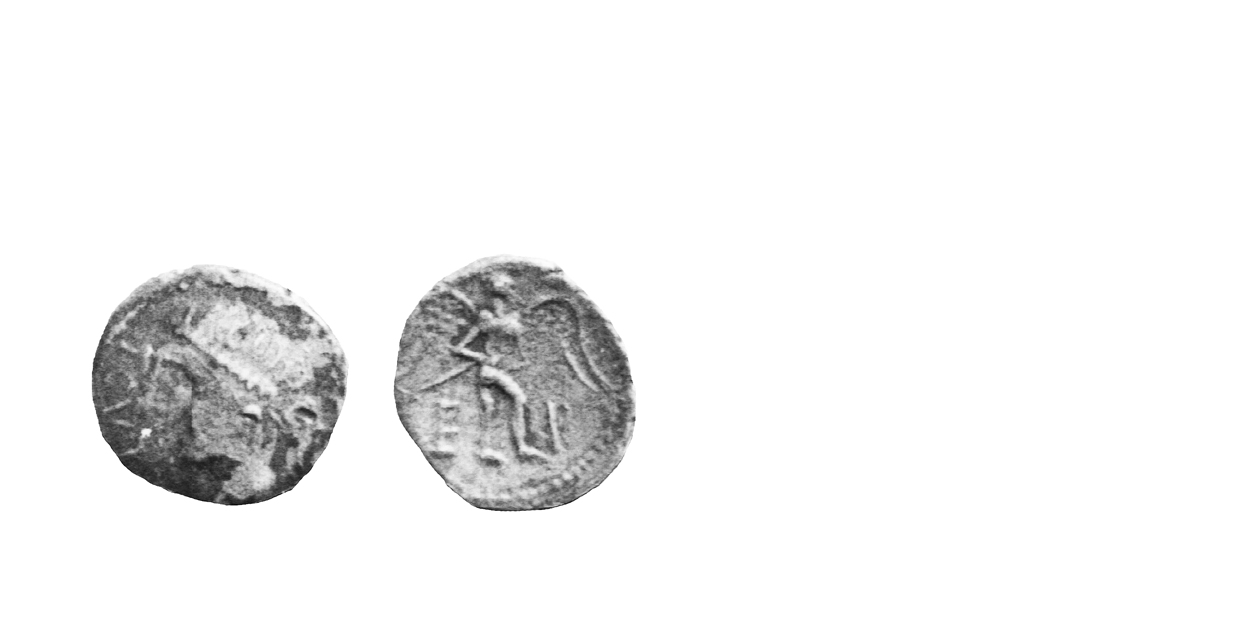
442 - 01 Eppillus Victory Type
10 B.C.-10 A.D. Extremely Rare
Silver Unit 1.3 gms. 12 mm
Earliest Record: Evans, 1864
OBV: Romanized head left
Identifying points:
1) head wears diadem
2) IOVIR in field
REV: Victory right
Identifying points:
1) E P beside victory
2) pellet border
CLASSIFICATION: Atrebatic H
NOTES:
- Most in museums
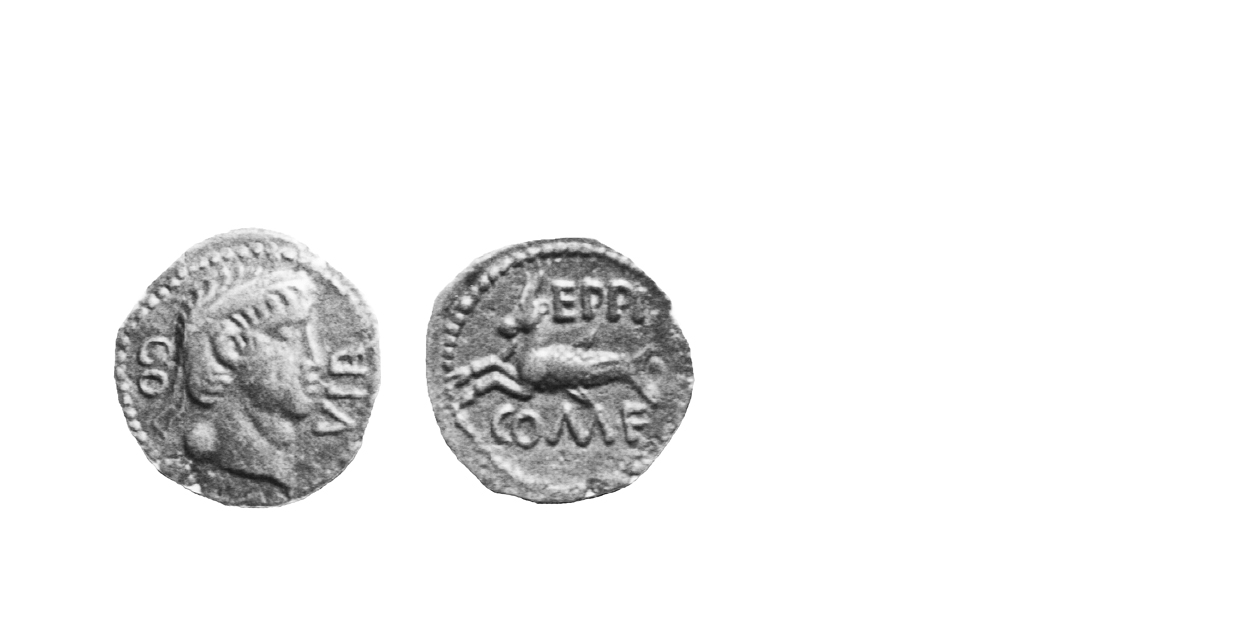
443 - 01 Eppillus
10 B.C.-10 A.D. Very Rare
Silver Unit 1.2 gms. 15 mm
Earliest Record: Camden, 1789 (Gough edition)
OBV: Celticized head right
Identifying points:
1) VIR in front of face
2) CO behind head
REV: Capricorn left
Identifying points:
1) EPPI above Capricorn
2) COMF below Capricorn
CLASSIFICATION: Atrebatic H
NOTES:
- Mack listed the coin twice as 308 and 308a to illustrate different portions of the image
- Obverse adapted from a Roman denarius, but it is not possible to identify the emperor precisely
- Reverse adapted from a denarius of Augustus
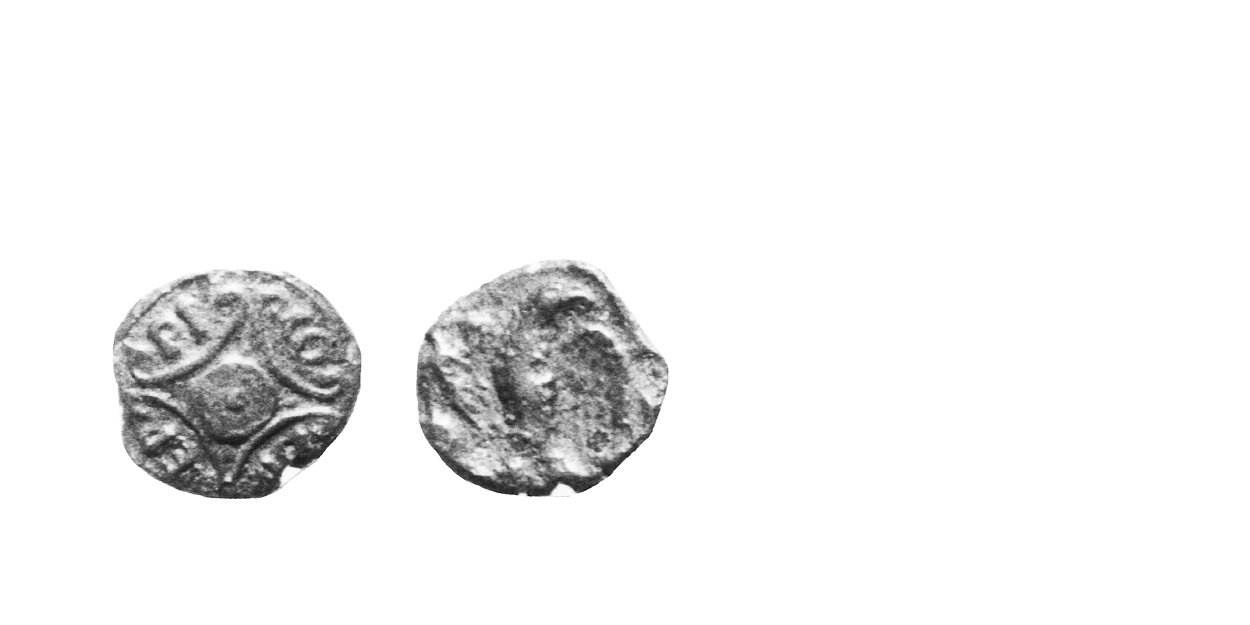
450 -01 Eppillus
10 B.C.-10 A.D. Very Rare
Bronze Unit 2.2 gms. 12 mm
Earliest Record: Poste, 1846
OBV: Geometric pattern
Identifying points:
1) large disc in centre
2) curve-sided square around disc
3) EP Pl CO MF around square
Identifying points:
1) eagle has spread wings
2) rings in field
CLASSIFICATION: Atrebatic H
NOTES:
- Most in museums
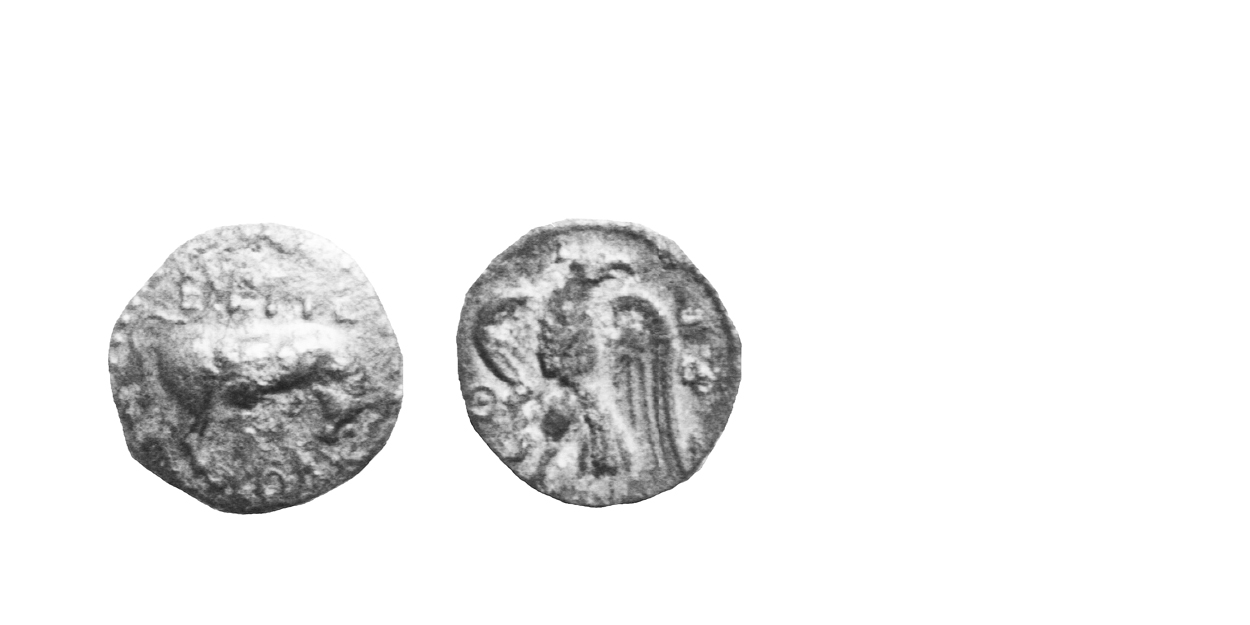
451 - 01 Eppillus
10 B.C.-10 A.D. Scarce
Bronze Unit 2.1-2.5 gms. 14 mm
Earliest Record: Evans, 1890
OBV: Bull right
Identifying points:
1) EPPI above bull
2) COF below bull
3) pellet border
REV: Eagle left
Identifying points:
1) eagle has spread wings
2) head turned to right
3) pellet-in-ring motif to left of eagle's feet
CLASSIFICATION: Atrebatic H
NOTES:
- Obverse adapted from a denarius of Augustus
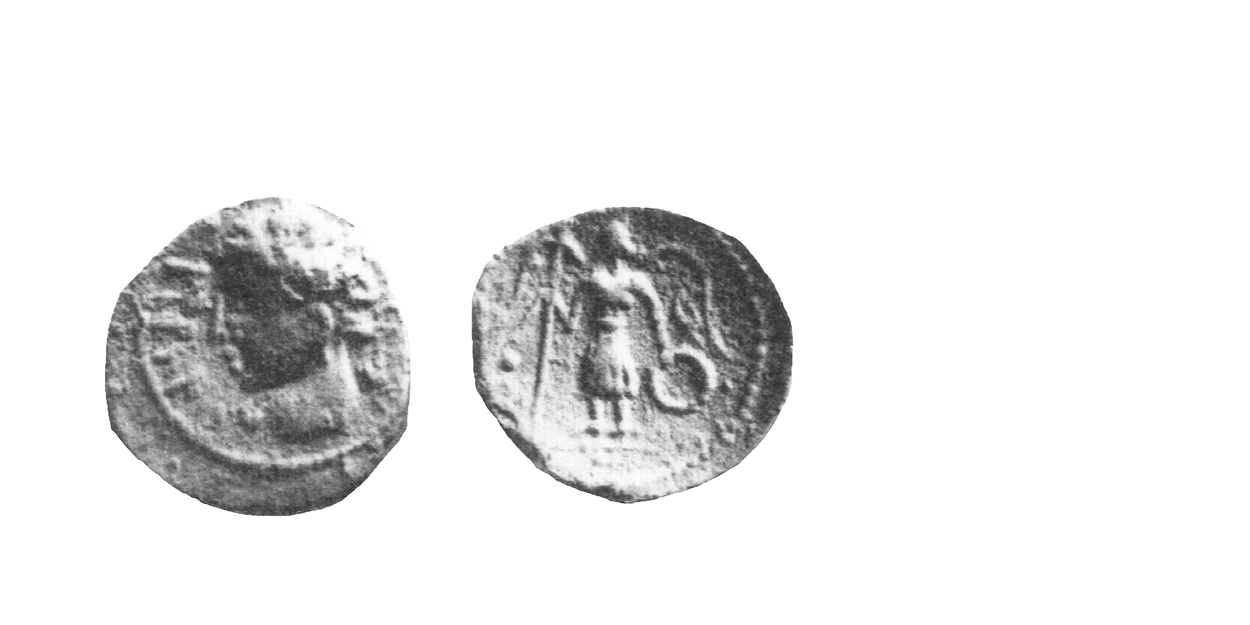
452 - 01 Eppillus
10 B.C.-10 A.D. Very Rare
Bronze Unit 1.9 gms. 16 mm
Earliest Record: Evans. 1864
OBV: Romanized head left
Identifying points:
1) EPPI in front of face
2) pellet border
REV: Victory left
Identifying points:
1) victory holds wreath in left hand and standard in right hand
2) victory stands on exergual line
3) pellet border
CLASSIFICATION: Atrebatic H
NOTES:
- Most in museums
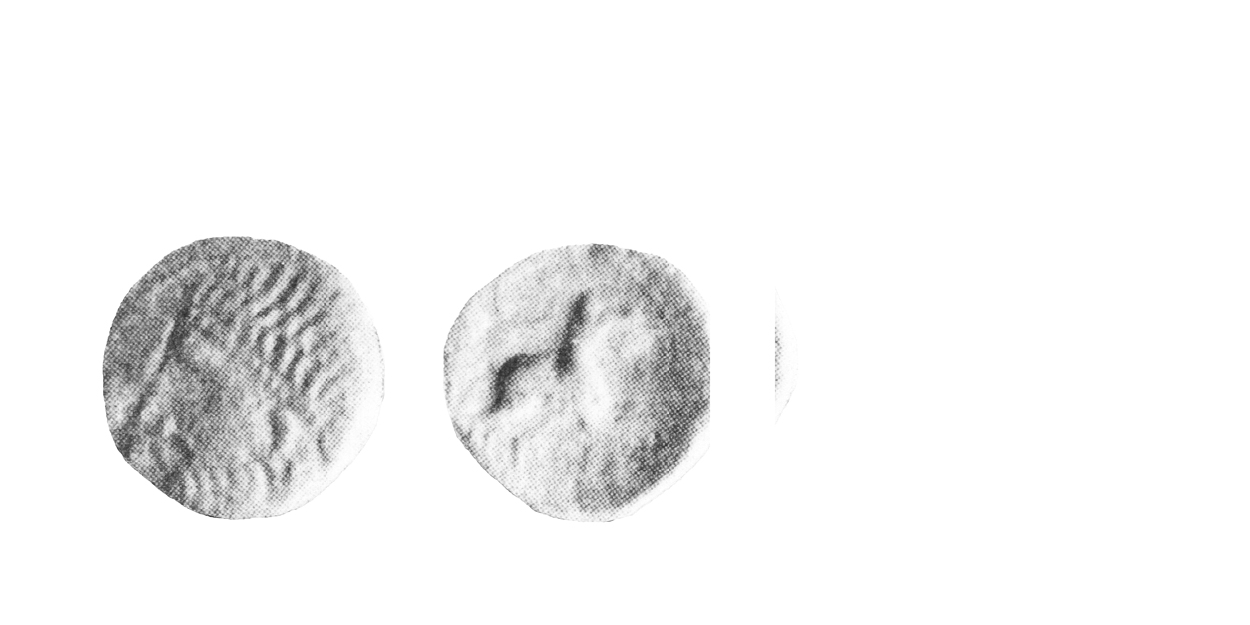
453 - 01 Eppillus
10 B.C.-10 A.D. Very Rare
Bronze Unit 2.2 gms. 15 mm
Earliest Record: Evans, 1864
OBV: Celticized head left
Identifying points:
1) head bearded
2) EPPI.C.F. in field
REV: Chariot right
Identifying points:
1) chariot has two horses
2) C.F. below chariot
CLASSIFICATION: Atrebatic H
NOTES:
- Many in museums
Coinage of the Atrebates, Regni & Belgae
The Atrebates, Regni and Belgae occupied the territory that is today Berkshire, Sussex and Hampshire. Whether three distinct political groups struck coins cannot be proven today, nor can separate territories be demonstrated. The Regni are virtually unknown to history until the Roman period, and the tribal area of the Belgae is a matter of controversy. Though Belgic immigration is mentioned by Caesar, he does not specifically say where they settled, and we only have the Roman name Venta Belgarum to suggest a location. The Atrebates, also mentioned by Caesar, had tribal members on both sides of the Channel.
Traditionally, the three tribes have been treated numismatically as one. Based on the current state of research, there is no reason to change this approach. Attempts have been made to identify a separate coinage for the Belgae. These have been largely, but not entirely, based on reports of new types of silver coins published in numismatic trade lists since 1994. The coins do not appear to form a coherent issue of a single issuing authority and questions exist regarding their precise status. These enigmatic coins demand careful analysis and reflection before they are accepted as evidence for a Belgic coinage. Certainly, after the Gallic War, only one coinage circulated in the territory. It may someday come to pass that coinages for the Belgae and Regni can be identified, but only after a rigorous analysis of the new types has been completed. Most of these are listed under "New Material". For the remainder of this discussion the three tribes will be referred to simply as the "Atrebates" for the sake of brevity.
Initially, the three tribes constituted one of the most advanced groups in Britain. They had trading contacts with Belgic Gaul in the late second and early first centuries B.C., and were one of the earliest to strike coins. The earliest stater, the INSULAR TYPE struck before the Gallic War, is derived from imported Gallo-Belgic C. The next coinage, the WESTERHAM TYPE, is now felt to be inspired by the Trinovantian/Catuvellaunian coinage of the same name, struck during the Gallic War. After the war, the tribal position changed dramatically, and the Atrebates may have fallen out of favour with the Romans. It is possible the cross-Channel trading rights were given to the Trinovantes/Catuvellauni instead. A loss of trading rights may have been the result of Commius' activities during the War.
Commius, at first a supporter of Caesar, became disillusioned with the Romans and went over to Vercingetorix. After the collapse of Celtic resistance at Alesia, he fled to join the British part of his tribe. Later, the Atrebates struck coins with his name, and possibly the acceptance of Commius in Britain was the reason they fell out of favour. The change in trading rights altered the relative fortunes of the two tribes forever. By the end of the millennium, the Trinovantes/Catuvellauni had economic influence throughout southern Britain and had begun to rival the Atrebates.
The Atrebates seized the opportunity of the Trinovantian/Catuvellaunian Interregnum to mount a military incursion into Kent under their leader, Eppillus. Eppillus struck a victory stater commemorating the initial success of the expedition. The incursion was cut short, however, by the elevation of Cunobeline to the Trinovantian/Catuvellaunian throne. He drove the Atrebates out of Kent and Eppillus promptly disappeared. He is replaced on the coins by Verica, a self-styled 'son of Commius'.
Sometime before the Claudian invasion, Verica was in turn overthrown. He probably was the historical Celtic leader 'Bericus' who appeared in Rome seeking aid from Claudius. Verica was replaced on the coins by Epaticcus, who styled himself a 'son of Tasciovanus'. Whether the family-tie was real is not so important, the result was the Atrebatic leadership was now held by a Trinovantian/Catuvellaunian sympathizer. Shortly before the Claudian invasion, Epaticcus was replaced by Caratacus, the famous leader of the British resistance against the Roman invaders. The Atrebatic coinage came to an end during the forties, as Caratacus fled westwards to lead the resistance amongst the tribes in Wales. One Atrebatic leader known to history, Cogidubnus, has not yet been identified on the coinage. It seems he was not elevated to leadership until the coinage had come to an end.
